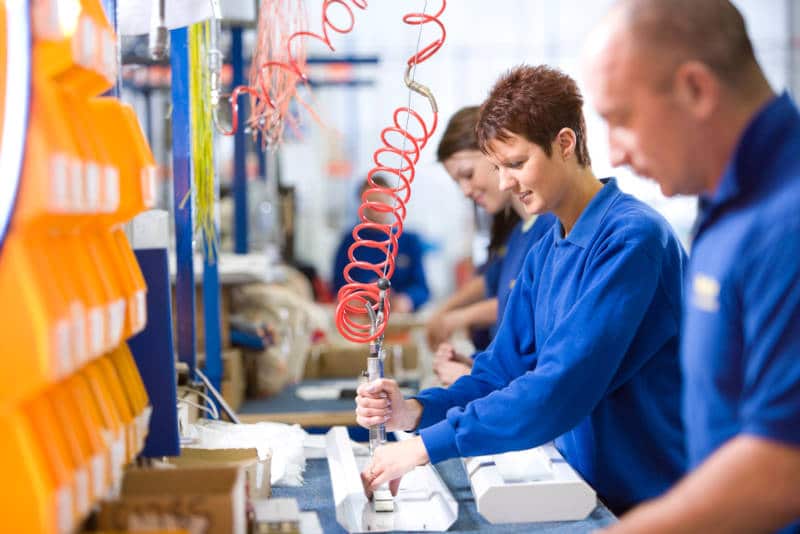The COVID-19 pandemic plunged the world into unprecedented health and economic crises. But, it also had a couple of silver linings. The pandemic’s disruption of the global supply chain set off a manufacturing renaissance. Many manufacturers are choosing to bring back operations to the U.S.
These operations include manufacturing and distribution processes that were previously done in China. Reshoring manufacturing and distribution will bring higher-paying jobs to the country.
Offshoring happened in the U.S. in the past. It affected some areas more than others. These areas will significantly benefit from reshoring efforts.
Reshoring will also drive up the demand for commercial and industrial real estate. Commercial real estate investors should prepare for the opportunities that reshoring will bring. They can look for locations that will be attractive for manufacturing and distribution uses.
According to a study by Thomasnet, 83% of manufacturers in North America are highly likely to reshore. This type of shift will increase the economic opportunity in the country. The study estimates that the shift will drive $443 billion in economic opportunity. Read on to better understand why companies are reshoring to the U.S. and its impact on the demand for real estate.
The History of American Manufacturing
What went wrong in manufacturing in the past? Answering that question will help investors better prepare for reshoring. In the past, factories in the U.S. produced more goods than any other factories around the world. Then companies started looking for cheaper labor and ended up outsourcing production.
Then the great recession came along. It hit the American manufacturing industry quite hard. Output from manufacturing declined by more than 20%. That was one of the most significant declines in years.
By the time 2010 rolled around, America had lost its manufacturing dominance. The loss affected the country’s economy. The commercial and industrial real estate industries were not spared.
Offshoring caused major occupancy losses in the manufacturing industry. Vacancy rates were at an all-time high, and China took the title of the largest manufacturing country in the world regarding output.

A Deep Dive into Reshoring
Reshoring refers to the act of bringing back manufacturing to the United States from overseas. After the financial crisis, American manufacturing experienced a major comeback. Many firms want to bring back production to the United States. There are economic and non-economic drivers for reshoring.
Reshoring has been going on steadily in the country for almost 10 years. Companies are bringing back manufacturing and distribution facilities. The pandemic accelerated the process. It did so by uncovering problems with supply chains. Thus, it encouraged companies to bring manufacturing back to the U.S.
Some benefits of reshoring include increased demand for commercial real estate. It also reduces unemployment because of the creation of high-paying manufacturing job opportunities. Further, reshoring encourages the development of a skilled workforce.
The location decisions that companies make will affect them for many years. So, companies have to select great sites for their operations. Commercial real estate investors should be keen to know where companies are relocating. With that information, they can create strategies for investing in commercial real estate.
Why Companies Choose to Reshore to the US
There are many reasons why firms choose to bring back manufacturing to America. Some of the reasons include:
#1. Reduced Energy Costs
The energy cost in the United States is a primary source of attraction for industries. A key driver for low energy costs is the country’s ability to get shale gas. Shale gas serves as a low-cost source of fuel. Thus, it encourages investment in new manufacturing and distribution facilities.
The shale oil revolution is a major reason why America has become energy-independent. With shale oil, companies can have a reliable source of power generation. Having a reliable source of power makes manufacturers more competitive. It also helps them with the transition to automation.
#2. More Effective Management of the Supply Chain
With reshoring, most components in the supply chain will share a similar time zone. So, managing the supply chain will be easier. It will also be possible to create more linear workflows.
If suppliers are nearby, there will be an increase in efficiency. Companies will deal with familiar transport systems in the country. They will also get rid of customs issues and tariffs. Plus, reshoring will mean a shorter delivery period. It will also mean working with suppliers who share the company’s values and quality standards.
By reshoring, companies can place language barriers in the past. Language barriers can turn seemingly small problems into huge issues. Reshoring reduces transportation costs to the final consumer. It also makes products more available. Reshoring mitigates risk by safeguarding the supply chain from disruptive events. Such events can lead to a delay in manufacturing.
#3. Rising Costs in Developing Nations
Countries all over the globe keep developing. As they develop, their labor costs and shipping costs also rise. Thus, the cost difference between operating offshore and in the country is relatively small. Plus, the gap in labor costs keeps closing each year.
The difference in labor costs between the U.S. and developing nations slowly disappears after adjusting for productivity. Also, labor rates in China have a greater annual percentage increase than in the U.S. With the wage gap closing, lower labor costs cease to be an enticing factor for offshoring. So, companies choose to reshore their companies to the U.S.
#4. Better Taxes and Tariffs
The American government wants to make taxation fair for everyone. Plus, some communities want to provide tax incentives to attract companies. After the great recession, there was a rise in incentives to attract business. The same is likely to happen as COVID-19 disappears. Reshoring also helps improve the national economy. Commercial real estate investors can be part of reshoring. They can do that by providing great locations for reshoring companies.

The Impact of Reshoring on Demand for Commercial and Industrial Real Estate
Reshoring causes a rise in manufacturing, leading to increased demand for commercial and industrial real estate. It’s especially true for warehouses, distribution centers, and manufacturing facilities.
The demand for warehouses and distribution centers is already high. That’s due in large part to the e-commerce sector. So, reshoring further drives up the demand for the two facilities.
Companies prefer having their distribution centers close to manufacturing facilities. Having the two close reduces transportation costs.
Thus, there will be an increase in demand for properties that can meet both distribution and manufacturing needs.
The Takeaway for Commercial Real Estate Investors
The U.S. manufacturing sector is rebounding, majorly because of reshoring. If the manufacturing sector thrives, so will the commercial real estate sector. Investors in commercial real estate should pay attention to sites that are ideal for manufacturing and distribution. Doing so will attract companies.
Investing in commercial real estate has many advantages. Examples are tax benefits and high returns. When the manufacturing sector crumbled in the past, factories became abandoned. Investors can identify these infrastructures and renew them for use by reshoring companies.
Wrapping Up
For many reasons, companies move manufacturing back to the U.S. from nations like China. As expected, reshoring increases the demand for real estate as companies look to settle. The increased demand presents a unique opportunity to investors. Thus, they should be ready to take advantage of such opportunities.
Contact EXtrance today to learn how we can help you improve your investment management processes.

